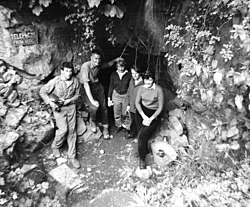Bakers Pit
 From Wikipedia - Reading time: 5 min
From Wikipedia - Reading time: 5 min
| Bakers Pit | |
|---|---|
 Baker's Pit Cave entrance in 1961 | |
| Location | Buckfastleigh, Devon, England |
| Coordinates | 50°29′4.61″N 3°46′28.41″W / 50.4846139°N 3.7745583°W |
| Length | 3,631 metres (11,913 ft) |
| Discovery | 1847 |
| Geology | Middle Devonian Limestone [1] |
| Entrances | 1 |
| Access | DCUC (key required) [2] |
Bakers Pit is a phreatic maze cave system near Buckfastleigh, Devon, England.
It was first opened in 1847 by quarrying activities.[3]
Bakers Pit is entered via a vertical descent of 16 metres.[3] It has 3.631 kilometres (2.256 mi) of passage contained within an area of 4 hectares (9.9 acres) and a small stream, flowing to the River Dart, that is still actively developing the cave.[1][3][4] It was once connected to Reeds cave, however, only "voice" connection is currently possible, and only in a few locations.[5] Connections between the two systems have been filled in with concrete to protect the beautiful formations in the Reeds cave.[6]
The cave was much frequented between the wars by local people during which time many of the calcite formations were destroyed,[3] although some formations have now naturally regenerated.[7] In the early 1960s an upper series was discovered significantly extending the known cave by as much as 50 per cent by climbing a vertical slot in the roof. This extension is better known as the Plymouth Extension and this area contains some of the best examples of formations due to its difficult access of squeezes and climbs. This upper series once went up to the surface but for conservation this has been sealed off with an emergency plan in place in case of rescue from this upper series.[citation needed].
Wildlife
[edit]Devon caves are good places to find humidity-loving collembola and Pseudosinella dobati (a blind white cave-adapted species), Symphyla isabellae, Tetracanthella britannica and Heteromurus nitidus have been recorded in Baker's Pit. Other invertebrates include the staphilinid beetle Quedius mesomelinus and the arachnid Lessertia denticalis.[8]
References
[edit]- ^ a b Waltham, A.C.; Simms, M.J.; Farrant, A.R.; Goldie, H.S. (1997). Karst and Caves of Great Britain. London: Chapman and Hall. pp. 275–276. ISBN 0412788608.
- ^ "Access to Devon Caves". Devon & Cornwall Underground Council. Retrieved 3 November 2012.
- ^ a b c d "BAKERS PIT CAVE". WILLIAM PENGELLY CAVE STUDIES TRUST. Archived from the original on 21 June 2009. Retrieved 3 November 2013.
- ^ "Longest caves". UK Caves database. Retrieved 15 June 2009.
- ^ "Reed's Cave". WILLIAM PENGELLY CAVE STUDIES TRUST. Archived from the original on 21 June 2009. Retrieved 15 June 2009.
- ^ "Baker's Pit - Reeds". UK Caves database. Archived from the original on 30 April 2009. Retrieved 15 June 2009.
- ^ "Bakers Pit" (PDF). Stretcher - Newssheet of the DCRO (1). Devon Cave Rescue Organisation: 5. 2001. Archived from the original (PDF) on 24 September 2006. Retrieved 3 November 2012.
- ^ Transactions of the British Cave Research Association vol 5; no 3; pp 168 & 195
 KSF
KSF